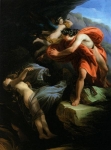Topics

Orfeo e Euridice [Orphée et Euridice] : dramma per musica / composto da Giusep. e Haydn ; traduit en vers français ; arrangé pour le piano-forte par Gerardin Lacour.
Paris : Mme. Masson, [1805]
Stanford University Libraries, Memorial Library of Music, MLM 495
Link to downloadable images of this work
Original title on the autograph score: Orfeo ed Euridice; title in Haydn’s catalogue: L'anima del filosofo ossia
Composed in 1791 and headed for the boards in the new Haymarket Theatre, Orfeo was cancelled due to recurring arts-patron rivalry between George III and his son, the Prince of Wales. The King and the Prince supported rival opera houses and seasons. The Prince was a patron of the Haymarket, and George III took it upon himself to refuse to grant a performing license to the Haymarket’s manager, Sir John Gallini, effectively mothballing the production of Orfeo at the new theatre.
Orfeo was the last of twelve operas Haydn composed, and the first intended for public performance (as opposed to the earlier works written for the Eszterháza court). Haydn’s operas never found a place in the canon, perhaps in part because most were written to specifications imposed both by the provincial performing forces and literary tastes at Eszterháza. And then there was Mozart. In a famous letter to Franz Roth, Haydn praises Mozart’s operatic genius and laments his own talents by comparison, when asked by Roth to compose an opera buffa:
“It would be quite another matter if I were to have the great good fortune to compose a brand new libretto for your theatre. But even then I should be risking a good deal, for scarcely any man can brook comparison with the great Mozart.”
Apparently, though, the allure of composing operas was in Haydn’s mind. Haydn’s biographer Griesinger writes, "Haydn observed at times that he ought to have written more lyrical music, for he could have become one of the first [finest] writers of operas.”
Orfeo was written in the opera seria style, which had begun to grow stale after Handel’s many earlier successes, though was later revived by the likes of Bellini and Donizetti. Carlo Badini’s libretto made some mess of the plot. As was later the case when Haydn was forced to compose to Badini’s text for The Seasons, Haydn managed to create effective music despite second-rate material. The vocal writing, alternately strong and delicate, contains flights of beauty and includes many challenging passages such as Genio’s coloratura aria, “Al tuo seno fortunate.” The choral and orchestral writing often sparkles.
An incomplete autograph manuscript of Orfeo survives in Berlin, and several copies approved by Haydn also exist in European repositories along with early printed excerpts. Compiling all available sources allowed for a recorded premiere in 1950 (Vienna State Opera; Handt, Hellwig, Heusser, cond. Swarowsky), a stage premiere in 1951 (Florence; Tyggeson, Callas, Christoff, cond. Kleiber), and finally, the publication of the critical edition in 1974 (Haydn Werke, Reihe XXV Bd. 13). Stanford’s score was published in Paris in 1805 or 1806 and is in Italian underlaid with a French translation. Like the 1805 Breitkopf edition, it includes eleven of the arias and choruses from the opera in a piano-vocal arrangement.
The premiere recording is available on CD at the Music Library.

The second Haymarket Theatre, 1791-1867
With thanks to Astrid Smith, Rare Book and Special Collections Digitization Specialist, and the Digital Production Group for providing downloadable images of the complete work.


 Stanford University Home
Stanford University Home
Add comment